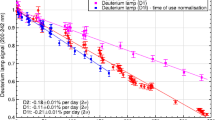Abstract
The knowledge of solar extreme and far ultraviolet (EUV) irradiance variations is essential for the characterization of the Earth’s upper atmosphere. For a long time, this knowledge has been based on empirical models, which are themselves based on proxies of the solar activity. However, the accurate modeling and prediction of the Earth’s upper atmosphere necessitate to improve the precision on the irradiance and its variations below about 200 nm. Here, we present a review of recent works made by the authors that aim at quantifying the irradiance variability at these wavelengths, and that lead to new way of monitoring the solar EUV/FUV irradiance spectrum. In more details, it is shown that the quantification of the high level of redundancy in the solar spectrum variability allows to envisage measuring only a small portion of the spectrum without losing essential knowledge. Finally, we discuss what should and could be measured in order to retrieve the solar extreme and far ultraviolet spectrum.
Similar content being viewed by others
References
Curdt, W., P. Brekke, U. Feldman, K. Wilhelm, B.N. Dwivedi, U. Schühle, and P. Lemaire (2001), The SUMER spectral atlas of solar-disk features, Astron. Astrophys. 375, 591–613, DOI: 10.1051/0004-6361:20010364.
Dudok de Wit, T., J. Lilensten, J. Aboudarham, P.-O. Amblard, and M. Kretzschmar (2005), Retrieving the solar EUV spectrum from a reduced set of spectral lines, Ann. Geophys. 23, 3055–3069.
Dudok de Wit, T., M. Kretzschmar, J. Aboudarham, P.-O. Amblard, F. Auchère, and J. Lilensten (2008), Which solar EUV indices are best for reconstructing the solar EUV irradiance?, Adv. Space Res. 42, 5, 903–911, DOI: 10.1016/j.asr.2007.04.019.
Golub, G.H., and C.F. van Loan (1996), Matrix Computations, Johns Hopkins Press, Baltimore, 3rd ed.
Hinteregger, H.E., K. Fukui, and B.R. Gilson (1981), Observational, reference and model data on solar EUV, from measurements on AE-E, Geophys. Res. Lett. 8, 11, 1147–1150, DOI: 10.1029/GL008i011p01147.
Hochedez, J.-F., W. Schmutz, Y. Stockman, et al. (2006), LYRA, a solar UV radiometer on Proba2, Adv. Space Res. 37, 2, 303–312, DOI: 10.1016/j.asr.2005.10.041.
Kretzschmar, M., J. Lilensten, and J. Aboudarham (2004), Variability of the EUV quiet Sun emission and reference spectrum using SUMER, Astron. Astrophys. 419, 1, 345–356, DOI: 10.1051/0004-6361:20040068.
Kretzschmar, M., J. Lilensten, and J. Aboudarham (2006), Retrieving the solar EUV spectral irradiance from the observation of 6 lines, Adv. Space Res. 37, 2, 341–346, DOI: 10.1016/j.asr.2005.02.029.
Lathuillère, C., M. Menvielle, J. Lilensten, T. Amari, and S.M. Radicella (2002), From the Sun’s atmosphere to the Earth’s atmosphere: An overview of scientific models available for space weather developments, Ann. Geophys. 20, 1081–1104.
Lean, L. (1990), A comparison of models of the Sun’s extreme ultraviolet irradiance variations, J. Geophys. Res. 95, A8, 11933–11944, DOI: 10.1029/JA095iA08p11933.
Lilensten, J., and J. Bornarel (2006), Space Weather, Environment and Societies, Springer Verlag, Dordrecht, DOI: 10.1007/1-4020-4332-5.
Lilensten, J., T. Dudok de Wit, P.-O. Amblard, J. Aboudarham, F. Auchère, and M. Kretzschmar (2007), Recommendation for a set of solar EUV lines to be monitored for aeronomy applications, Ann. Geophys. 25, 6, 1299–1310.
Lilensten, J., T. Dudok de Wit, M. Kretzschmar, P.-O. Amblard, S. Moussaoui, J. Aboudarham, and F. Auchère (2008), Review on the solar variability spectrum for space weather purposes, Ann. Geophys. 26, 269–279.
Richards, P.G., J.A. Fennelly, and D.G. Torr (1994), EUVAC: A solar EUV flux model for aeronomic calculations, J. Geophys. Res. 99, A5, 8981–8992, DOI: 10.1029/94JA00518.
Tobiska, K. (1993), Recent solar extreme ultraviolet irradiance observations and modeling: A review, J. Geophys. Res. 98, A11, 18879–18893, DOI: 10.1029/93JA01943.
Tobiska, W.K. (2001), Validating the solar EUV proxy, E10.7, J. Geophys. Res. 106, A12, 29969–29978, DOI: 10.1029/2000JA000210.
Tobiska, W.K., T. Woods, F. Eparvier, R. Viereck, L. Floyd, D. Bouwer, G. Rottman, and O.R. White (2000), The SOLAR2000 empirical solar irradiance model and forecast tool, J. Atmos. Sol.-Terr. Phys. 62, 1233–1250, DOI: 10.1016/S1364-6826(00)00070-5.
Warren, H.P., J.T. Mariska, and J. Lean (2001), A new model of solar EUV irradiance variability. 1. Model formulation, J. Geophys. Res. 106, A8, 15745–15758, DOI: 10.1029/2000JA000282.
Woods, T.N., F.G. Eparvier, S.M. Bailey, P.C. Chamberlin, J. Lean, G.J. Rottman, S.C. Solomon, W.K. Tobiska, and D.L. Woodraska (2005), Solar EUV Experiment (SEE): Mission overview and first results, J. Geophys. Res. 110, A1, A01312, DOI: 10.1029/2004JA010765.
Author information
Authors and Affiliations
Corresponding author
Rights and permissions
About this article
Cite this article
Kretzschmar, M., Dudok de Wit, T., Lilensten, J. et al. Solar EUV/FUV irradiance variations: analysis and observational strategy. Acta Geophys. 57, 42–51 (2009). https://doi.org/10.2478/s11600-008-0066-2
Received:
Accepted:
Published:
Issue Date:
DOI: https://doi.org/10.2478/s11600-008-0066-2




